#and the highest rated place we could find only had french menus and the staff preferred to speak in french
Text
ok paris trip! cheeky summary :-) (limited by image count lol)
we went up to the artists streets bc i wanted to see the big church and i was fully charmed by the buildings, different areas have very different charms to them. i took a lot of photos of fragments of buildings like these two. i always take pictures like this, the charm of a city comes through in the life reflected in ordinary houses


also big church. pretty. i dont follow Christianity but they sort of went off with the architecture
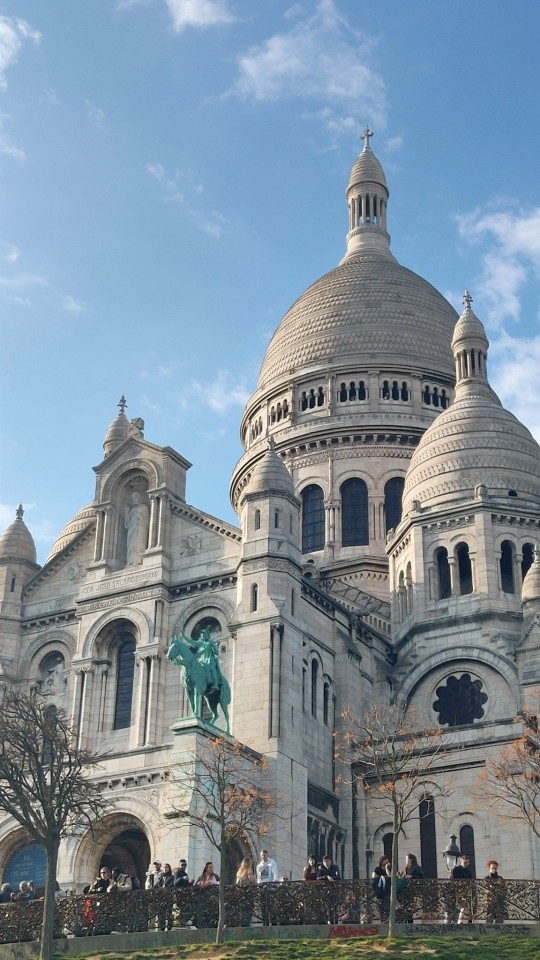
TWO pyramid selfies for your viewing pleasure. i didnt know there was an upside down one as well! i also did a really bad job at aligning my hand to the pyramids ndjshdjddn

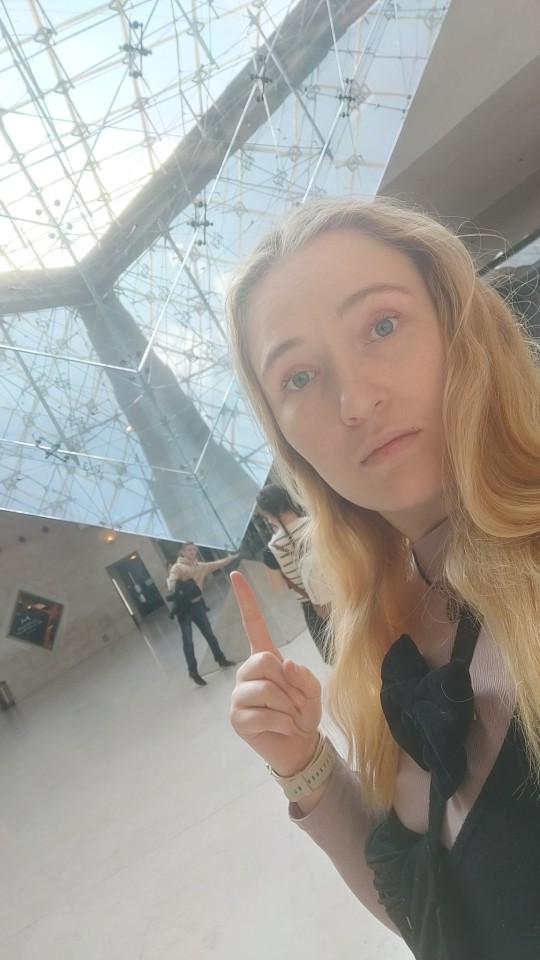
louvre. i love a statue. miss venus was so incredible in person.
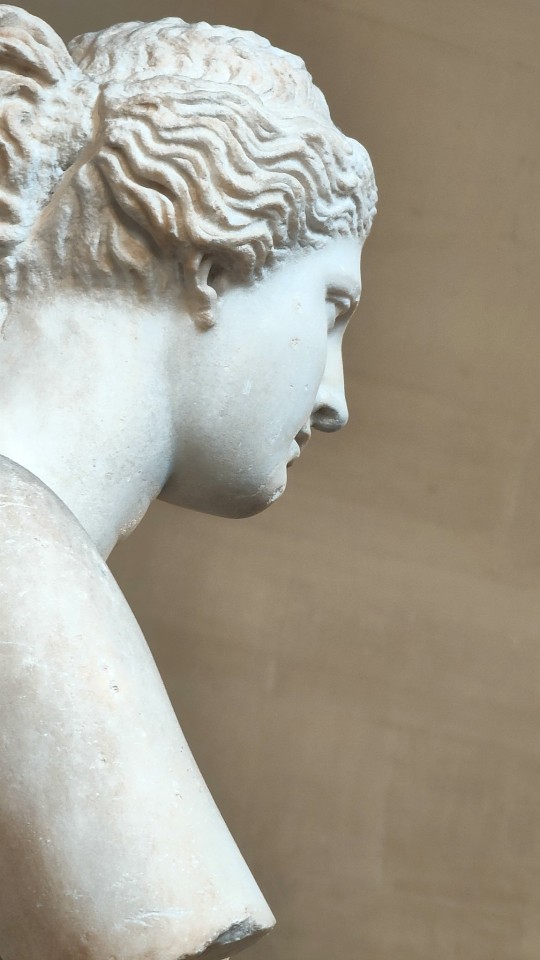

this was my second favourite statue(tte?) in the louvre. after miss venus. its from mexico 300-400AD and its a little fella with a WARRIOR INSIDE.
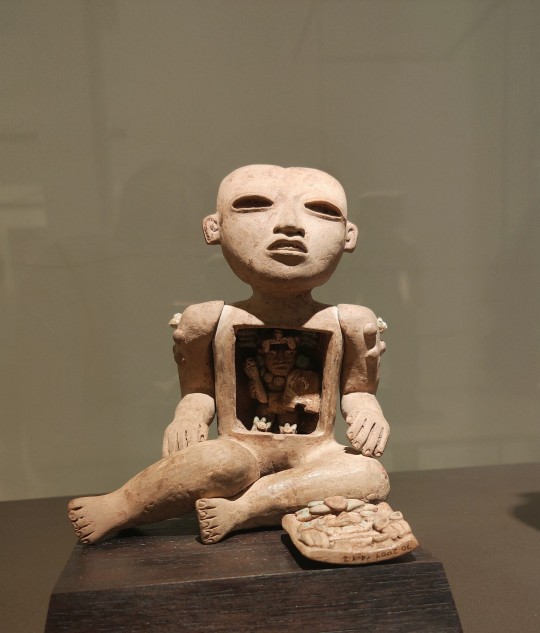
and on the final day we went to the eiffel tower. the scale of it is always insane to me, they have this other teeny eiffel tower built near it which looks big when youre next to it. then the further away you get the scale of the real eiffel tower becomes evident (its in the second photo, on the right behind the trees)


tumblr has limited me to 10 photos :( so not pictured: me getting immediately addicted to petit déjeuner with cafe créme, the teeny apartment out of the city centre we were staying, with a bistro where a guy gave me a free shot of limoncello because it was my birthday:)) the fancy dinner we went to, the selfies i took with liberty leading the people (!!!!), the little video i took blowing a kiss to spain, photos of other tourist-y and less tourist-y areas, the 100 other louvre photos i took 😂
#literally only there for two days total - arrived Friday afternoon left sunday afternoon - but packed in a lot!#my dad lived in france and speaks fluent french which was helpful bc i decided on the last day that i wanted to get crepes#and the highest rated place we could find only had french menus and the staff preferred to speak in french#i struggled with the basic baby french i know but its difficult for me cos i havent studied it since iw as like 12?13?#so when i reach for french my brain usually goes to spanish or if i rly dont know the word. chinese. its embarrassing#the number of times i wanted to ask where the bathroom is and my brain went zai- no donde- no ou - yes!#clown wig: ON#.jtxt
23 notes
·
View notes
Link
[AO3 LINK] [EF LINK]
NOTE: ¥100 is roughly $0.90 US, for Americans who don't want to have to stop reading and google, which I totally understand. Just approximate ¥100 =$1 for somewhat close conversion purposes.
Also, this is where the story really begins to take off. The setup is complete: let the yuri begin!
CHAPTER FOUR
~ x The Priestess x ~
Less than two hours later, I was sitting nervously on a bed in Dogenzaka. Love Hotel Hill. The last place I ever expected to find myself.
Just in case you don't know about it - which I doubt, Sis - that's where all young couples go when they need a night to themselves. Or just a few hours. Maybe the problem is a messy apartment, maybe it's parents… maybe it's just very thin walls in their building. Either way, love hotels do a lot of business - and that little corner of Shibuya plays host to the highest concentration of them in Tokyo. Finding one that would rent to me for a couple of hours without me already having the second person in tow was the easy part, and only cost me ¥3000.
Especially easy considering my disguise.
The hardest part was actually making the phone call. It took every ounce of courage I had, especially because I would be disguising my voice - which was something I didn't have a lot of experience doing. The memory of the call was still fresh in my mind…
"Housekeeping Service Victoria! What can we do for you today, sir?"
"Um… can I have… a maid?" Did I mention I was also the most nervous I had ever been in my life?
"Sure," the woman on the other end giggled. "That's what we're here for! Do you have a special request, or would you like me to describe a few of our top-rated maids and what services they can help you with?"
"I want Miss K-" That had been a close one. "W-what I mean is, do you have a maid named Becky?"
"Oh! I can certainly transfer you to Becky and see if she's available! One moment please."
Some pleasant, inoffensive harpsichord music played in the background until the transfer connected. The entire time, I had been sweating bullets, practicing making my voice even deeper.
"Hiiii! You've reached Becky! How may I help you today, meow?"
"Two hours. How much?" The less I said, the better.
"That will be ¥10000! Are you sure you need me for two hours, Master? I might be able to get all my work done in half that time!"
"Yes." Her calling me 'master' was already giving me nausea. But I tried to power through; I had to know what she was doing. After all, sweet Ann had given me half the money to request her, so the least I could do was follow through. "Hotel Juliet. Here is the address…"
And that was that. She didn't even waste a second hesitating when I gave her the address of a love hotel; just took it in stride. Which already seemed to be confirming my worst fears, but I told myself that I wouldn't back down or make any more assumptions; that would be even worse than confirming the truth.
So I made the room the tiniest bit messy while I waited for her. Then I sat on the bed, shaking like a leaf and sweating bullets. Right up until I heard the knock at the door.
"Housekeeping!" she called in a sing-song.
"Come in!" She came in. And already, I really wished she hadn't.
My Japanese language teacher stood before me wearing the same frilly black-and-white French maid outfit. What parallel universe did I step into?! Her hair was up in pigtails that hung down to her shoulders - or rather, it was a wig. No way her natural hair was long enough for that. A layer of foundation helped to conceal the very slight signs of ageing, making her passable for 21 or similar. Not that I knew how old she really was.
"It is nice to meet you, Master," she said with a playful curtsy. Really, I didn't think curtsies could be playful, but she did it.
"Good evening," I attempted in my best impression of a male voice.
"My my myyyeeow, but you're so handsome," she buttered me up with a flutter of her mascaraed eyelashes. "I'm such a lucky girl that you'll let me get covered in dust for you!"
"Th-thank you." Was I really handsome, though? My disguise was pretty believable. Ann helped me a lot with it, especially doing the stage makeup that made me look like I had a five o'clock shadow. But it was the big bushy mustache and having my shoulder-length hair stuffed up into fedora that made me look different enough that my teacher might not notice.
She stepped out of her Mary Janes and paced a little closer away from the door. "So! Let's just take care of that silly fee and we can get started right away! Victoria said you would pay in person?"
"Oh! Right, um…" Quick as I could, I fished out ¥10000 and handed it over. A double-shift for her. She pocketed it immediately, not even batting an eye. How many times had she done this?
"Thanks sooooo much! You're the best, Master! What can Becky do for you today?"
"U-um, well… get started on this mess. Then we can relax." That sounded really cheesy and sleazy, but it was the best I could do.
"Of course," she said with a huge wink as she fished a laminated card out of her apron pocket. "You can check this out while I get started! Should only take me a few minutes!"
I accepted it without really thinking, then watched numbly for a moment as she began to tidy up the pillows and sheets I had strewn around the floor. Humming a little tune as she worked. Finally, I decided the card might actually be important and took a look.
Hello, Master! Thank you for using Victoria Housekeeping Service! My name is BECKY ! I'm happy to do whatever you need!
Standard services include:
-Sweeping, mopping, vacuuming, dusting
-Making beds/Airing out futons
-Laundry
-Light cooking
-Conversation
Premium services (additional charge):
-Dancing alone ¥500
-Dancing together ¥500
-Lap kitten ¥1000
-Lap pillow ¥1000
-Tucking you in ¥1000
-Stocking removal ¥1000
-Keep stockings ¥5000
-Foot/neck massage ¥1000
-Deep back massage ¥2000
-Health Massage ¥5000 (Note: maid may refuse at any time)
-Health Kiss ¥10000 (Note: maid may refuse at any time)
Prohibited requests:
-Pictures
-Kissing the maid
-Touching the maid without explicit permission, with any part of the client's body or objects under their control
Our maids are very important to Victoria! Please treat me with kindness and care! ❤
That had me reeling. Just that Miss Kawakami had to specify that nobody was allowed to touch her without her permission… this was her life after school was out. Being constantly hit on by men who had her all alone in their houses. She must have spent a lot of time hating herself on the inside. I had to wonder if that contributed to how weary she always looked, beyond simply being tired. But then I saw the fine print at the bottom of the card:
Our employees (maids) are not prostitutes and are not allowed to participate in sexual intercourse with unspecified persons. Violators of this policy will be prosecuted to the fullest extent of the law. All names and locations of clients are noted in our records and employees who do not report in are treated as victims of crime and the clients as the responsible parties until proven otherwise.
Well… at least there was that.
"Soooo," my temporary maid asked as she picked up the condoms I had dumped out of the bedside table drawer - which I now was horrified about since I hadn't even noticed what they were before, "my master seems to have been very messy just for meeee. Was there another reason you called our service?"
The twinkle in her eye when she winked at me said it all: this was a love hotel. Even if I somehow partied so hard in two hours that I trashed the room, no way would I need to call a separate maid when the hotel staff would take care of that.
"L-lonely," I grumbled, trying to seem standoffish.
"Awwww, that's okay. I offer a lot of premium services, but… if you just wanna talk, we can talk. Becky doesn't mind at all." She finished putting them away, then straightened and folded her hands in front of her lap, waiting patiently for my response. Obediently.
"Um…" Glancing back down at the card, I looked up and asked, "K-keep stockings?"
Only when her eyebrows went up did I realise what that meant. But she was already recovering from her brief surprise and saying, "Master, you really want to keep my stockings? I'm so honoured!"
"W-wait, no, I…" Clearing my throat, desperately trying to deepen my voice again, I tried to play it off. "Maybe later. First… what is 'dancing alone'?"
"Ohhh. Oh, I see - you're just trying to decide what you like on the menu. Do you want a little sample?"
At first, I thought she meant a sample of the stockings. Was she going to cut off a piece?! But then she started doing a little sexy dance - nothing extremely lewd, but it definitely made my pulse speed up slightly. Was this really happening? My teacher was dancing for me - like a stripper without the stripping part! But it was over after only about ten seconds, and then she was giggling and covering her mouth.
"Dancing alone… got it. Very nice." As she bowed, an idea suddenly occurred to me. "Tell me about Becky." Maybe if I asked, she would reveal a little bit about herself. Or I would get some made-up story about this character she had invented. Either way, at least she wouldn't be sitting in my lap or any of those things.
"Sure! May I sit here?" When I nodded, she sank down onto the bed next to me, hands folded neatly on her lap. "Do you like Japanese maids, or Western maids?"
"Japanese?"
"Alrighty. So, Becky used to be a little girl whose father liked Western movies. That's how she got such a funny name! And she always dreamed of serving others, making them feel good. She didn't always know how she wanted to do that, but…" She leaned a little closer, and my heart pounded louder in my chest. "Then she one day realised that if she took this job, she would meet Master someday."
"Huh?" Her face was even closer, and my fingers gripped the bedsheet tightly as I fought the instinct to back up. "Me?"
Her nod was completely sure. "My master was going to be the best master. And he would take care of me like I take care of him. That's all Becky ever wanted out of life." Similarly, her smile was warm, and kind. "And I will do whatever I can to make him happy. Okay?"
"Okay. I m-mean… yeah."
"Good!" she sat back with a wider smile, and I let out a sigh of relief. Definitely a made-up story, just to make the client feel gratified in some way. How different listening to that had been from listening to one of her lectures in class; it was like she really was a completely different person.
"Becky," I began as I thought about the list. What was something I could order? I already booked her for two hours, so now I had to find something to do that would fill that time. "What is, um… Health Kiss?"
This shift was obvious, and I could almost reach out and touch the change in atmosphere. Miss Kawakami's eyes dulled for a moment, and she looked through me rather than at me. She took a couple of little breaths. Then a much less genuine smile reappeared on her face - though it might have fooled most of her hornier, less perceptive clientele.
"It's something very special. Becky only gives that to her best Masters, if she can. Sometimes she can't. Is… is that alright with Master?"
"Yes!" I told her right away, eyes wide. "I'm sorry, I… it's okay. I just was curious." Definitely something sexual. That was as much as I really needed to find out, but now I felt awful for asking. My teacher was a Delivery Health professional, even if those services were limited to two sexual acts, apparently.
"Of course. Master can ask whatever he wants!" A little of the genuine cheer started to come back, but she was still shaken. "Well, what can we do? I like talking with Master, but it's okay if Master wants something more from Becky. Even just…" She gestured around. "You don't happen to have a broom, do you?"
"No." I thought frantically. Literally everything on the list of special services intimidated me; how was I supposed to let her sit on my lap? Or massage me?! She would feel my curves underneath the random boy clothes! My finger tapped the stockings. "Are you hot in those?"
Kawakami shrugged a tiny bit. "A little, but I want to look nice for Master. Unless… Master wouldn't mind seeing me without them…?"
"Yes. I… wait." I glanced at the card again, then nodded to myself and fished out another bill. There went my allowance… "Here."
She took it and put it with the rest. None of the standard services besides talking were open to me in a random hotel room, and I was running out of things to say. This was the lesser of the evils; taking off her stockings and the sexy dancing were the only premium ones that didn't involve me, so I thought one of those was probably the smartest move. And at least all this would mean was seeing her legs, and I had seen plenty of girl-legs. It wasn't going to matter to me.
How wrong I was.
"Oooh, I really am hot," she giggled as she began running her hands up and down the outsides of her thighs. "Master had me work so hard to clean the room that now… Becky's so warm…" She bit her bottom lip as she slid her hands up her skirt…
This was unbelievable. Both that I was watching Miss Kawakami strip for me, and that it was affecting me. My heart rate was up, my palms tingling, my head buzzing like it was full of bees. She was a woman! She was my teacher! What on earth was wrong with me?!
Barely an inch of skin became visible beneath the hem of the skirt where it rested above her knees when she fixed me with a level stare. "Master…"
"Huh? What?!" Then I cleared my throat, made my voice more 'butch' again. "I mean… is there a problem?"
"You paid to take them off," she breathed throatily, fluttering her lashes again. "Don't you want to?"
Oh no. I thought I was just paying for her not to be wearing tights anymore. Not for the 'pleasure' of taking them off myself.
"It's alright? I mean… I'll be touching you."
"It's what my Master wants, so of course it is. But I trust you not to let those greedy hands go anywhere!" She admonished me with a wagging finger and a big grin, as if we were joking around; we both knew I wasn't going to do any such things. How laughable!
But there was a pinprick of fear in her eye. She was probably always worried she would get a client who didn't understand the way things worked.
"N-no, ma'am," I said automatically. That did get her blinking a few times, but I quickly followed up with, "This is all I want."
And I leaned down and began to push them off. At first, I tried to do it without really touching her, but I looked stupid and she chuckled a little. It was probably 'cute'. So then I pet along her legs a little before trying again, my grip firmer as I began to pull them down.
"Careful!" she warned me. "You'll tear them if you go too fast. Besides… this is all for you. Take your time! I want Master to have as much fun as he wants with my stockings."
Would this nightmare never end?! Not only did I have to do this now that I paid for it, or else she would figure out something was up, but I had to take my time and 'enjoy myself' - even though what I really wanted was to run screaming from Hotel Juliet as fast as my legs could carry me. Trying to take the safe option, I had gone from watching my teacher strip to stripping my teacher in a matter of seconds. Whoops.
Kawakami did have great legs; clean-shaven and smooth, like she spent a lot of time moisturising. It was easier than I expected to whisper, "Very nice."
"Thank you, Master." She scooted back a little further on the bed as I sat back to get the opaque white fabric moving down along her calves. They were heavily-perfumed, probably just for this reason. And the perfume was nice… but I could catch the vaguest hint of something else underneath the floral scent. Probably her natural scent.
Not that I wanted to think about it. Not that I wanted to do this at all.
"Silly Master," she giggled as I teased the fabric back and forth around her ankles, milking the moment. Now it was more because I didn't know what I was going to do once it was over. Rub my face on them? Pet her legs? Just put them on the bed and lock myself in the bathroom? The last one sounded fantastic at this point.
"Am I?"
"Yes." She booped my nose with her big toe and I couldn't help smiling. Why was that so cute? Why was any of this cute?! "Becky's happy you're having fun with her!"
Though I didn't forget to pitch my voice low, I ended up telling her very honestly, "I guess I am. Wow." Then I refocused and slid the stockings the rest of the way off.
"Oh myyyyy. I guess Master has to see Becky's feet now." Somehow, the tone of her voice made it very clear that she was fishing… because she was. Did she think I had a thing? Her little toes began to 'walk' up the front of my button-up and blazer, heading for my neck, but at a snail's pace. I could stop her very easily. She just wanted to find out what I was curious about and if she could cater to those needs in small ways.
"Guess so." I caught them and held on to keep them from moving higher. "I don't mind at all."
Again, she blinked in surprise, her mood shifting. But she seemed a lot more flattered than fearful this time. "You know… if Master decided he wants a Health Massage after all, Becky could use these…" Her toes flexed in my hands. "If you're patient with me. Becky hasn't tried that before."
"I'll keep that in mind," I hedged, trying not to mentally picture whatever that would be. The idea of sitting here, helping my teacher take off her clothes while she called me 'Master' was already enough to short-circuit my brain; I didn't need additional elements.
But then I was distracted for a second. Kawakami was calculating. I knew that look from you, Sis; when you have a case weighing heavy on your mind, it always happens before you either come up with a new angle for a lead, or work through a puzzle that had been giving you a hard time. Then…
Then she knelt down on the floor, suddenly filling my vision. Glancing down, I could see her cleavage — and forced myself to look back into her chocolatey eyes instead.
"M-miss… Becky…"
"Becky will stop if you want," she whispered very quietly. "But if you can pay the fee… Becky thinks she would like to help her master be more healthy. Take care of… whatever he needs." Her hand fell to pet up and down my side…
That was how the game changed. Suddenly it wasn't just about her body being real, and sensual, in a way no one else's had ever been in my eyes - despite my efforts to prevent that. Now she had awakened mine. And even knowing that it was a specific, intentional, targeted attempt to make me give in and pay her that ¥5000… well, I had never been in a position like this before.
"I don't know," I managed to get out, trying to back up but failing to do it well enough - or quickly enough - to convince her. "I might not… be ready."
"I think you're ready," she whispered as her hand slid up the inside of my thigh. "But don't worry. Becky will do whatever it takes to make you… feel…"
Her hand went higher than I expected that soon after she started. And this, more than anything else, sent pure shock into her wide eyes.
"…healthy?"
To Be Continued…
#Queen Of Temperance#forkanna writes#niijima makoto#kawakami sadayo#persona 5 fanfiction#persona 5#p5#p5 fanfic#jess the writer
0 notes
Link
It’s early morning on Shanghai’s West Bund, and the lawns of the waterfront area are filled with picnickers savoring the annual cherry-blossom bloom. Parents push strollers through carpets of flowers while students sprawled on the grass share bottles of chilled cava. After three months of strict stay-at-home orders because of the COVID-19 pandemic, residents of China’s biggest city have re-emerged blinking into the light. “It’s crazy; I’ve never seen it so busy here,” says Sally Zhou, as she queues for coffee with her French bulldog. “People are desperate to get outside and enjoy themselves.”
Even as COVID-19 spreads across the world, nowhere has replicated the scale and intensity of China’s unprecedented lockdown. The epicenter of the outbreak, Wuhan, was sealed off and other cities placed under quarantine. The world’s No. 2 economy froze completely. Those sacrifices have now enabled China to slow new cases to a trickle. Wuhan discharged the last of its hospitalized coronavirus patients on April 27, and although many are skeptical of the government’s reported case numbers, authorities clearly feel confident enough to allow certain schools and businesses across China to reopen. Sales at major online retailers grew around 10% year-on-year in March, according to China’s Commerce Ministry, partly in response to a flurry of cut-price deals designed to rekindle demand. On April 22, President Xi Jinping emphasized the imperative to restart China’s stalled economy. “Great advances in history have come after great catastrophes,” he said.
For much of the world, the catastrophe is still ongoing–at least 3 million cases and more than 200,000 deaths in more than 200 countries and territories as of late April. In February, the world marveled as China threw up temporary hospitals in Wuhan; now, similar facilities sit in London’s largest convention center and in New York City’s Central Park. Medical masks, long de rigueur in Asia to guard against infection, are now worn by most venturing outside in much of the Western world. The new hot spots of the virus have armed themselves with defenses pioneered in Asia: the potent trident of social distancing, widespread testing and protecting frontline medical workers.
The coronavirus is far from defeated, but in many places, the initial surge in cases has abated and focus has turned to the fate of the global economy. The IMF estimates global GDP will shrink 3% this year and that contraction may continue into 2021, which could lead to the deepest dive since the Great Depression. The U.S. economy shrank 4.8% in the first quarter, and J.P. Morgan predicts a 40% contraction in the second. The number of Americans claiming unemployment is now 22 million.
With statistics like these, some feel as if the cure may hurt more than the disease. Protests have broken out in the U.S. against lockdown measures, which are already being rolled back in states including Georgia, Montana and Tennessee. But health officials warn that easing measures too quickly risks a W-shaped recovery, where a resurgence of cases causes a second economic decline soon after the first.
There’s no playbook for successfully lifting lockdown. But several East Asian countries are further ahead in the game. How they are faring offers invaluable lessons in the effort to balance public health and economic recovery.
It was about 4 P.M. on March 7 when Park Hong-cheol, 42, received a call from his local health authority in South Korea informing him that a colleague in his office had tested positive for COVID-19. He quickly donned a surgical mask and drove to Sejong City’s Public Health Center. After he filled out registration forms, hazmat-suited staff performed a COVID-19 test through a crack in his car window. Afterward, officials sprayed disinfectant on his car’s exterior and Park drove straight home, obeying strict instructions to stay indoors and avoid human contact. “By the time I awoke the next morning, I had a text message saying that I’d tested negative,” he tells TIME.
At the start of the coronavirus outbreak, South Korea had been caught off guard; a slow initial rate of infection quickly metastasized in mid-February. But unlike in the U.S., which confirmed its first COVID-19 case one day after South Korea, a robust public health response kept reported cases under 11,000. Compared with the U.S., South Korea on a per capita basis tested three times as many citizens.
The ability to test and trace every infection and their contacts is one of six conditions the WHO says should be met before any society can reopen, and South Korea shows you don’t have to be an autocratic system like China’s to introduce these kinds of expansive measures. By April 24, more than 589,000 Koreans had been tested in the same way as Park Hong-cheol, in large part at drive-through and walk-through facilities that delivered quick results. The government provided free smartphone apps that relayed emergency SMS alerts about spikes in infections in neighborhoods, and updated national and local government websites that tracked cases. Infections with only mild symptoms were treated at temporary facilities to allow hospitals to concentrate on the most acute cases. As a result, South Korea successfully flattened the curve in 20 days without extreme draconian restrictions on freedom or movement. “The faster we find the contacts, the better we are able to stem further spread of the virus,” South Korean Health and Welfare Minister Park Neung-hoo tells TIME. Still, he adds, “finding a midpoint between economic activities and containing an epidemic outbreak is a delicate balancing act.”
Swift, decisive action has no doubt lessened the economic hit South Korea will have to bear (although its economy still shrank 1.4% in the first quarter of the year). Park, the Health Minister, says test results that arrive in minutes, not days, are “critical” to effective contact tracing. Then anonymized GPS data from an infected person’s cell phone can be used to automatically alert via SMS those people who had recently been in the same vicinity to get tested themselves. Other methods use interviews, security cameras and credit-card data to trace infected people. Hong Kong and Taiwan have enjoyed similar success.
The U.S. is poorly positioned to follow. For one, problems in the supply and capacity of testing kits mean it typically takes several days for results–and that delay exponentially increases the potential for infected people to expose others. For another, there are only around 2,200 professional contact tracers in the U.S., and health experts say 100,000 more are desperately needed. In China, around 9,000 contact tracers were employed in Wuhan alone.
There are also privacy issues; Americans generally don’t want their telecom companies to share their GPS data with government agencies, even if rendered anonymous and used to fight an extraordinary health crisis. Apple and Google are currently collaborating on an app that will use geodata to facilitate contact tracing–but, they insist, on a voluntarily opt-in, self-reporting basis.
And the app may not be ready for weeks, “It is very, very difficult to get people to opt into anything,” says Kai-Fu Lee, a venture capitalist; former Google, Microsoft and Apple executive; and author of AI Superpowers: China, Silicon Valley, and the New World Order. “It begs the question of which is more important: personal privacy or, during national pandemic emergencies, to use data in a restricted, anonymized way for public health.”
The government of Taiwan made its choice early. The island of 23 million realized it was extremely vulnerable given its position just 80 miles off mainland China, where 850,000 of its citizens reside and another 400,000 work. But in addition to early screening and detection, emergency powers also enabled smartphone location tracking to form “electronic fences” around people under quarantine, imposing steep fines if they leave home. Thanks to these precautionary measures, Taiwan has had fewer than 500 cases to date.
Yet even the most efficiently staged recoveries can prove fragile. Singapore, an affluent city-state of 5.6 million, was initially commended by the WHO for its widespread testing and comprehensive tracing of close contacts. Singapore requisitioned 7,500 hotel rooms to quarantine new arrivals, including some at the storied colonial-era Raffles Hotel. Sure, room-service menus were off-limits–simple meals on trays were provided instead–but the state still picked up the tab. On March 23, the island permitted schools to reopen, confident the virus was under control.
It turned out, however, that authorities had paid little attention to Singapore’s million or so low-paid migrant workers, and all the while COVID-19 was flourishing in their cramped dormitories–the largest of which house up to 25,000 workers. Over a week in April, case numbers rocketed by more than 250% to over 10,000–the highest tally in Southeast Asia. Ripon Chowdhury, 31, a shipyard worker from Bangladesh who has lived in Singapore for 10 years, was sharing a room with 15 others when the virus tore through his community. “It’s just too crowded,” he says. “If one person gets it, then all of us will, because we’re sharing a toilet, shower and kitchen.”
Singapore shows that any response to this indiscriminate virus must be inclusive. Americans on low incomes who cannot work from home and lack comprehensive health insurance have proven particularly vulnerable, as have elderly people trapped in care homes. But the virus cannot be banished from society by prioritizing the young and affluent. In Singapore, like the U.S., rich and poor take the same public transportation, use the same ride-sharing apps, prowl the same malls. “The virus doesn’t respect community barriers,” says Christine Pelly, an executive committee member of Singapore’s Transient Workers Count Too, a nongovernmental organization. “We benefit a lot from [low-wage workers]. We should look after their well-being more closely.”
Singapore is not the only Asian nation to have suffered a “second wave.” Japan was one of the first nations affected, not least because of the stricken Diamond Princess cruise liner docked south of Tokyo. But early on, it was actually Japan’s northern island of Hokkaido that was worst hit. Home to 4% of the population, the province roughly the size of Maine had a third of Japan’s 206 cases at the end of February, mainly owing to Chinese visitors to the Sapporo Snow Festival. A state of emergency was declared Feb. 28, with schools shut and residents ordered to stay at home.
But as cases mushroomed in urban areas like Tokyo and dropped in Hokkaido, the island’s authorities grew concerned by the economic toll. Kazushi Monji, the mayor of the town of Kutchan, some 50 miles from Sapporo, tells TIME the shutdown had a “serious impact” upon the local economy with restaurants empty, hotel reservations canceled and practically no new bookings. On March 19, Hokkaido lifted its state of emergency after just three weeks.
“People in Hokkaido became so happy, relaxed and relieved–walking around, going for drinks, attending business meetings,” says Dr. Kiyoshi Nagase, president of the Hokkaido Medical Association who helped coordinate the local COVID-19 response. Quickly, the situation spiraled with a flurry of new infections. On April 12, a second state of emergency was imposed. “Now I regret it,” says Nagase. “We should not have lifted the first [order].”
For chef Koji Yorozuya, whose parents started the Wafuchubo Mikami Izakaya in Otaru, northern Hokkaido, 20 years ago, the lockdown has become the “most severe crisis in the history of our restaurant.” Normally, all 40 seats would be occupied with customers enjoying warm sake alongside dishes of sashimi, tempura and grilled seafood skewers. But health regulations have forced him to shut up shop, and he now serves only taxi deliveries. “Honestly, I want the restrictions lifted as soon as possible because I am afraid of losing my restaurant,” he says. “But in terms of public health, I am also scared. I don’t know what the right answer is.”
As Hokkaido demonstrates, a town or province that has conquered its infection rate can relapse with alarming ease. Kazuto Suzuki, vice dean of international politics at Hokkaido University, says his province’s experience shows that the piecemeal opening up of U.S. states is “very dangerous … even if you control the first wave, you can’t relax.” In Texas, state parks have already reopened and nonessential surgeries resumed. On April 24, Oklahoma’s nail salons, spas, barbershops and pet groomers were allowed to resume work. Georgia’s gyms, bowling alleys and tattoo parlors flung open their doors the same day. “I’d love everything open,” Las Vegas Mayor Carolyn Goodman recently told CNN. But individual states’ actions pose a serious risk to the rest of the U.S. “The whole world is on fire with coronavirus,” says Michael Osterholm, the director of the Center for Infectious Disease Research and Policy at the University of Minnesota and co-author of Deadliest Enemy: Our War Against Killer Germs. “So all 50 states are going to contribute to each other. We’re only as strong as our weakest link.”
The question every country has to answer is what recovery looks like in a post-coronavirus world. New Zealand has had extraordinary success in conquering the virus, partly as a consequence of its isolation and low population density but also because it introduced strict lockdown measures and all but closed its borders. Now, daily new infections are down to single digits and it’s poised to banish the virus completely.
Still, the banning of all foreign nationals is having a catastrophic effect on the country’s tourism-reliant economy. Over 2019, international tourists to New Zealand spent just over $10 billion: the sector employs 8.4% of the workforce. All this has now evaporated. “The economy can survive without international tourism, but not as we know it,” says Brad Olsen, senior economist at New Zealand’s Infometrics consultancy firm.
Economic superpowers are no less at risk. China’s economy contracted 6.8% in the first quarter of 2020. Although domestic demand is now picking up again, China’s exposure to the global marketplace will mean the pain lasts for some time–and will have unpredictable repercussions. The dearth of demand for goods by Americans sequestered in their homes, for example, means Chinese factories run at reduced capacity, slashing the demand for energy, which helped crude-oil prices plummet below $0.
After the 2008 financial crisis, China invested in its recovery through infrastructure. It plowed $586 billion into government projects like highways, metro systems and airports, and poured more cement between 2011 and 2013 than the U.S. used in the entire 20th century. One result of that spending binge was soaring national debt, but it also resulted in millions of jobs in the short term and an enhanced foundation for every Chinese business to operate.
Beijing now appears reluctant to repeat that feat, but it might work for the U.S., which has so far focused on injecting liquidity into bond markets, making grants to small business and sending $1,200 checks to individuals. Analysts say the U.S. needs to spend some $4.5 trillion by 2025 to fix its creaking roads, railways and airports, plus upgrade to next-generation technology like 5G. Economists say infrastructure is an equalizer that empowers all businesses–big and small–and should be prioritized over bailing out lenders once again.
It’s early, but already clear that one legacy of the coronavirus will be a changed economic landscape. Almost half a million companies in China declared bankruptcy during the first quarter of the year. How many American firms fold depends on choices made today–by officials, and by people anxious for answers. The only thing worse than closed doors is a public too terrified to walk through open ones.
–With reporting by STEPHEN KIM/SEOUL; ABIGAIL LEONARD/TOKYO; AMY GUNIA and HILLARY LEUNG/HONG KONG
0 notes
Text
New top story from Time: What Asian and Pacific Countries Can Teach the World About How to—and How Not to—Reopen Our Economies
It’s early morning on Shanghai’s West Bund, and the lawns of the waterfront area are filled with picnickers savoring the annual cherry-blossom bloom. Parents push strollers through carpets of flowers while students sprawled on the grass share bottles of chilled cava. After three months of strict stay-at-home orders because of the COVID-19 pandemic, residents of China’s biggest city have re-emerged blinking into the light. “It’s crazy; I’ve never seen it so busy here,” says Sally Zhou, as she queues for coffee with her French bulldog. “People are desperate to get outside and enjoy themselves.”
Even as COVID-19 spreads across the world, nowhere has replicated the scale and intensity of China’s unprecedented lockdown. The epicenter of the outbreak, Wuhan, was sealed off and other cities placed under quarantine. The world’s No. 2 economy froze completely. Those sacrifices have now enabled China to slow new cases to a trickle. Wuhan discharged the last of its hospitalized coronavirus patients on April 27, and although many are skeptical of the government’s reported case numbers, authorities clearly feel confident enough to allow certain schools and businesses across China to reopen. Sales at major online retailers grew around 10% year-on-year in March, according to China’s Commerce Ministry, partly in response to a flurry of cut-price deals designed to rekindle demand. On April 22, President Xi Jinping emphasized the imperative to restart China’s stalled economy. “Great advances in history have come after great catastrophes,” he said.
For much of the world, the catastrophe is still ongoing–at least 3 million cases and more than 200,000 deaths in more than 200 countries and territories as of late April. In February, the world marveled as China threw up temporary hospitals in Wuhan; now, similar facilities sit in London’s largest convention center and in New York City’s Central Park. Medical masks, long de rigueur in Asia to guard against infection, are now worn by most venturing outside in much of the Western world. The new hot spots of the virus have armed themselves with defenses pioneered in Asia: the potent trident of social distancing, widespread testing and protecting frontline medical workers.
The coronavirus is far from defeated, but in many places, the initial surge in cases has abated and focus has turned to the fate of the global economy. The IMF estimates global GDP will shrink 3% this year and that contraction may continue into 2021, which could lead to the deepest dive since the Great Depression. The U.S. economy shrank 4.8% in the first quarter, and J.P. Morgan predicts a 40% contraction in the second. The number of Americans claiming unemployment is now 22 million.
With statistics like these, some feel as if the cure may hurt more than the disease. Protests have broken out in the U.S. against lockdown measures, which are already being rolled back in states including Georgia, Montana and Tennessee. But health officials warn that easing measures too quickly risks a W-shaped recovery, where a resurgence of cases causes a second economic decline soon after the first.
There’s no playbook for successfully lifting lockdown. But several East Asian countries are further ahead in the game. How they are faring offers invaluable lessons in the effort to balance public health and economic recovery.
It was about 4 P.M. on March 7 when Park Hong-cheol, 42, received a call from his local health authority in South Korea informing him that a colleague in his office had tested positive for COVID-19. He quickly donned a surgical mask and drove to Sejong City’s Public Health Center. After he filled out registration forms, hazmat-suited staff performed a COVID-19 test through a crack in his car window. Afterward, officials sprayed disinfectant on his car’s exterior and Park drove straight home, obeying strict instructions to stay indoors and avoid human contact. “By the time I awoke the next morning, I had a text message saying that I’d tested negative,” he tells TIME.
At the start of the coronavirus outbreak, South Korea had been caught off guard; a slow initial rate of infection quickly metastasized in mid-February. But unlike in the U.S., which confirmed its first COVID-19 case one day after South Korea, a robust public health response kept reported cases under 11,000. Compared with the U.S., South Korea on a per capita basis tested three times as many citizens.
The ability to test and trace every infection and their contacts is one of six conditions the WHO says should be met before any society can reopen, and South Korea shows you don’t have to be an autocratic system like China’s to introduce these kinds of expansive measures. By April 24, more than 589,000 Koreans had been tested in the same way as Park Hong-cheol, in large part at drive-through and walk-through facilities that delivered quick results. The government provided free smartphone apps that relayed emergency SMS alerts about spikes in infections in neighborhoods, and updated national and local government websites that tracked cases. Infections with only mild symptoms were treated at temporary facilities to allow hospitals to concentrate on the most acute cases. As a result, South Korea successfully flattened the curve in 20 days without extreme draconian restrictions on freedom or movement. “The faster we find the contacts, the better we are able to stem further spread of the virus,” South Korean Health and Welfare Minister Park Neung-hoo tells TIME. Still, he adds, “finding a midpoint between economic activities and containing an epidemic outbreak is a delicate balancing act.”
Swift, decisive action has no doubt lessened the economic hit South Korea will have to bear (although its economy still shrank 1.4% in the first quarter of the year). Park, the Health Minister, says test results that arrive in minutes, not days, are “critical” to effective contact tracing. Then anonymized GPS data from an infected person’s cell phone can be used to automatically alert via SMS those people who had recently been in the same vicinity to get tested themselves. Other methods use interviews, security cameras and credit-card data to trace infected people. Hong Kong and Taiwan have enjoyed similar success.
The U.S. is poorly positioned to follow. For one, problems in the supply and capacity of testing kits mean it typically takes several days for results–and that delay exponentially increases the potential for infected people to expose others. For another, there are only around 2,200 professional contact tracers in the U.S., and health experts say 100,000 more are desperately needed. In China, around 9,000 contact tracers were employed in Wuhan alone.
There are also privacy issues; Americans generally don’t want their telecom companies to share their GPS data with government agencies, even if rendered anonymous and used to fight an extraordinary health crisis. Apple and Google are currently collaborating on an app that will use geodata to facilitate contact tracing–but, they insist, on a voluntarily opt-in, self-reporting basis.
And the app may not be ready for weeks, “It is very, very difficult to get people to opt into anything,” says Kai-Fu Lee, a venture capitalist; former Google, Microsoft and Apple executive; and author of AI Superpowers: China, Silicon Valley, and the New World Order. “It begs the question of which is more important: personal privacy or, during national pandemic emergencies, to use data in a restricted, anonymized way for public health.”
The government of Taiwan made its choice early. The island of 23 million realized it was extremely vulnerable given its position just 80 miles off mainland China, where 850,000 of its citizens reside and another 400,000 work. But in addition to early screening and detection, emergency powers also enabled smartphone location tracking to form “electronic fences” around people under quarantine, imposing steep fines if they leave home. Thanks to these precautionary measures, Taiwan has had fewer than 500 cases to date.
Yet even the most efficiently staged recoveries can prove fragile. Singapore, an affluent city-state of 5.6 million, was initially commended by the WHO for its widespread testing and comprehensive tracing of close contacts. Singapore requisitioned 7,500 hotel rooms to quarantine new arrivals, including some at the storied colonial-era Raffles Hotel. Sure, room-service menus were off-limits–simple meals on trays were provided instead–but the state still picked up the tab. On March 23, the island permitted schools to reopen, confident the virus was under control.
It turned out, however, that authorities had paid little attention to Singapore’s million or so low-paid migrant workers, and all the while COVID-19 was flourishing in their cramped dormitories–the largest of which house up to 25,000 workers. Over a week in April, case numbers rocketed by more than 250% to over 10,000–the highest tally in Southeast Asia. Ripon Chowdhury, 31, a shipyard worker from Bangladesh who has lived in Singapore for 10 years, was sharing a room with 15 others when the virus tore through his community. “It’s just too crowded,” he says. “If one person gets it, then all of us will, because we’re sharing a toilet, shower and kitchen.”
Singapore shows that any response to this indiscriminate virus must be inclusive. Americans on low incomes who cannot work from home and lack comprehensive health insurance have proven particularly vulnerable, as have elderly people trapped in care homes. But the virus cannot be banished from society by prioritizing the young and affluent. In Singapore, like the U.S., rich and poor take the same public transportation, use the same ride-sharing apps, prowl the same malls. “The virus doesn’t respect community barriers,” says Christine Pelly, an executive committee member of Singapore’s Transient Workers Count Too, a nongovernmental organization. “We benefit a lot from [low-wage workers]. We should look after their well-being more closely.”
Singapore is not the only Asian nation to have suffered a “second wave.” Japan was one of the first nations affected, not least because of the stricken Diamond Princess cruise liner docked south of Tokyo. But early on, it was actually Japan’s northern island of Hokkaido that was worst hit. Home to 4% of the population, the province roughly the size of Maine had a third of Japan’s 206 cases at the end of February, mainly owing to Chinese visitors to the Sapporo Snow Festival. A state of emergency was declared Feb. 28, with schools shut and residents ordered to stay at home.
But as cases mushroomed in urban areas like Tokyo and dropped in Hokkaido, the island’s authorities grew concerned by the economic toll. Kazushi Monji, the mayor of the town of Kutchan, some 50 miles from Sapporo, tells TIME the shutdown had a “serious impact” upon the local economy with restaurants empty, hotel reservations canceled and practically no new bookings. On March 19, Hokkaido lifted its state of emergency after just three weeks.
“People in Hokkaido became so happy, relaxed and relieved–walking around, going for drinks, attending business meetings,” says Dr. Kiyoshi Nagase, president of the Hokkaido Medical Association who helped coordinate the local COVID-19 response. Quickly, the situation spiraled with a flurry of new infections. On April 12, a second state of emergency was imposed. “Now I regret it,” says Nagase. “We should not have lifted the first [order].”
For chef Koji Yorozuya, whose parents started the Wafuchubo Mikami Izakaya in Otaru, northern Hokkaido, 20 years ago, the lockdown has become the “most severe crisis in the history of our restaurant.” Normally, all 40 seats would be occupied with customers enjoying warm sake alongside dishes of sashimi, tempura and grilled seafood skewers. But health regulations have forced him to shut up shop, and he now serves only taxi deliveries. “Honestly, I want the restrictions lifted as soon as possible because I am afraid of losing my restaurant,” he says. “But in terms of public health, I am also scared. I don’t know what the right answer is.”
As Hokkaido demonstrates, a town or province that has conquered its infection rate can relapse with alarming ease. Kazuto Suzuki, vice dean of international politics at Hokkaido University, says his province’s experience shows that the piecemeal opening up of U.S. states is “very dangerous … even if you control the first wave, you can’t relax.” In Texas, state parks have already reopened and nonessential surgeries resumed. On April 24, Oklahoma’s nail salons, spas, barbershops and pet groomers were allowed to resume work. Georgia’s gyms, bowling alleys and tattoo parlors flung open their doors the same day. “I’d love everything open,” Las Vegas Mayor Carolyn Goodman recently told CNN. But individual states’ actions pose a serious risk to the rest of the U.S. “The whole world is on fire with coronavirus,” says Michael Osterholm, the director of the Center for Infectious Disease Research and Policy at the University of Minnesota and co-author of Deadliest Enemy: Our War Against Killer Germs. “So all 50 states are going to contribute to each other. We’re only as strong as our weakest link.”
The question every country has to answer is what recovery looks like in a post-coronavirus world. New Zealand has had extraordinary success in conquering the virus, partly as a consequence of its isolation and low population density but also because it introduced strict lockdown measures and all but closed its borders. Now, daily new infections are down to single digits and it’s poised to banish the virus completely.
Still, the banning of all foreign nationals is having a catastrophic effect on the country’s tourism-reliant economy. Over 2019, international tourists to New Zealand spent just over $10 billion: the sector employs 8.4% of the workforce. All this has now evaporated. “The economy can survive without international tourism, but not as we know it,” says Brad Olsen, senior economist at New Zealand’s Infometrics consultancy firm.
Economic superpowers are no less at risk. China’s economy contracted 6.8% in the first quarter of 2020. Although domestic demand is now picking up again, China’s exposure to the global marketplace will mean the pain lasts for some time–and will have unpredictable repercussions. The dearth of demand for goods by Americans sequestered in their homes, for example, means Chinese factories run at reduced capacity, slashing the demand for energy, which helped crude-oil prices plummet below $0.
After the 2008 financial crisis, China invested in its recovery through infrastructure. It plowed $586 billion into government projects like highways, metro systems and airports, and poured more cement between 2011 and 2013 than the U.S. used in the entire 20th century. One result of that spending binge was soaring national debt, but it also resulted in millions of jobs in the short term and an enhanced foundation for every Chinese business to operate.
Beijing now appears reluctant to repeat that feat, but it might work for the U.S., which has so far focused on injecting liquidity into bond markets, making grants to small business and sending $1,200 checks to individuals. Analysts say the U.S. needs to spend some $4.5 trillion by 2025 to fix its creaking roads, railways and airports, plus upgrade to next-generation technology like 5G. Economists say infrastructure is an equalizer that empowers all businesses–big and small–and should be prioritized over bailing out lenders once again.
It’s early, but already clear that one legacy of the coronavirus will be a changed economic landscape. Almost half a million companies in China declared bankruptcy during the first quarter of the year. How many American firms fold depends on choices made today–by officials, and by people anxious for answers. The only thing worse than closed doors is a public too terrified to walk through open ones.
–With reporting by STEPHEN KIM/SEOUL; ABIGAIL LEONARD/TOKYO; AMY GUNIA and HILLARY LEUNG/HONG KONG
via https://cutslicedanddiced.wordpress.com/2018/01/24/how-to-prevent-food-from-going-to-waste
0 notes
Text
Sneak Peak at Trinidad’s Newest Restaurant: ZaZou Kitchen
Over centuries, French cuisine has been transformed into the art of combining the freshest ingredients with conservative amounts of herbs and sauces to create an unapologetically smug dish. For its short four-year history, Zazou Bistro Moderne (now ZaZou Kitchen) has made these characteristics the heart of their cuisine, despite their Facebook page modestly defining their food as ‘Fusion with a French Flair’.
In the wake of ZaZou’s recent announcement that they will be moving to One Woodbrook Place (set to open the third week in July 2017), our Saltin’ team visited ZaZou at its former location at Country Club at Champs Elysées, Long Circular Road to offer some insight into what fellow foodies can expect from One Woodbrook’s newest addition.
ZaZou’s decision to relocate from its Country Club roots seems like a step in the right direction. With a reputation of being both notorious and distinguished depending on who you ask, Country Club has had its fair share of scandals and soirées throughout history.
First gifted to a French family in the 1700s, Country Club has always been synonymous with exclusivity and grandeur, permitting only those who ranked as society’s highest to frolic within its walls. This discrimination, though beneficial to some, manifested itself into a reputation for prejudice based on race or social standing, with one case even making international news when an American couple was disallowed from using the Club’s tennis court. A spot for ZaZou at the just-as-posh One Woodbrook Place where all of society can feel fully welcomed means that a perfect stage is finally set to introduce ZaZou Kitchen’s version of French cooking to the entire nation.
While Trinidad awaits this new food adventure, Saltin’ is here to offer a sneak peak into ZaZou’s foundation. Ratings were done by our team at their original Country Club location in four main categories; Ambience and Décor, Flavour, Customer Service and Value for Money. The fifth category, Overall Experience, gives an average score (scroll to the bottom to see a summary in this category if you don’t like to read!).
Ambience and Décor – 8.6 out of 10
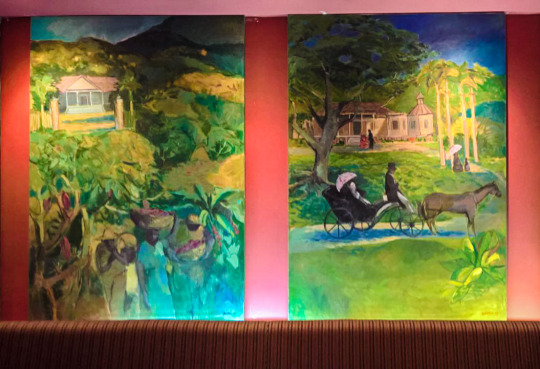
It’s hard to spoil the unquestionably beautiful landscape of the Country Club grounds and the design of its main building. While here, ZaZou stayed true to the estate’s history by keeping the building’s tall shuttered windows and Spanish colonial doors. Palm trees and dark-wood furniture were complemented by simple canary yellow and white table spreads. Large chalkboard menus added a rustic touch, and although some things seemed gaudy, these were balanced by tasteful décor such as a large painting of historical Country Club life. We are excited to see how they will translate this style into their new restaurant at One Woodbrook Place.
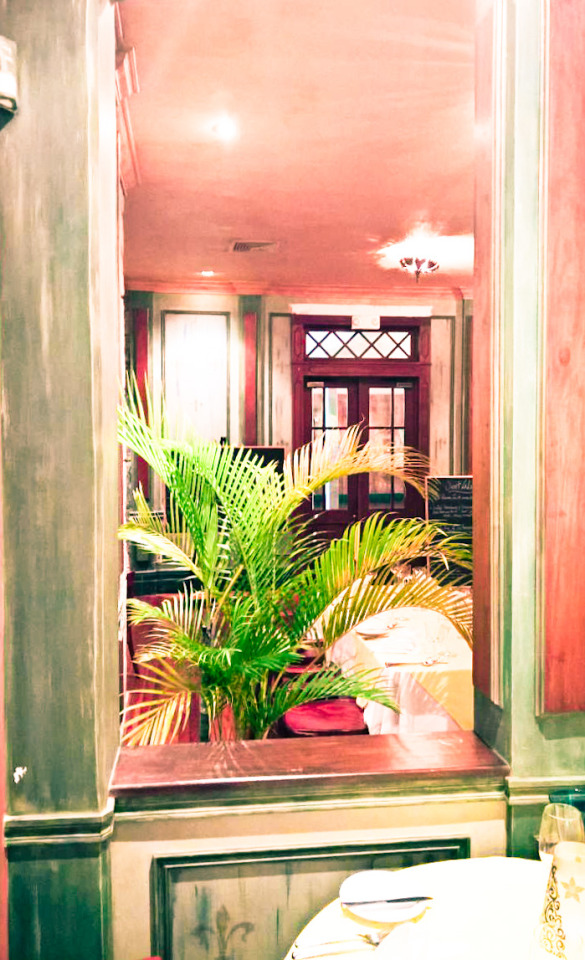
Flavour – 9 out of 10
To our delight, the culinary experience at ZaZou was far superior to its location’s namesake in France – the restaurants along Avenue des Champs Elysées in Paris, France are oftentimes pricey tourist-traps with sub-standard food. We must mention that ZaZou’s former menu wasn’t large, and chances are they might stick to this model for their new location. Still, the food was mostly spectacular with a few shortfalls.
Two major things that ZaZou got wrong were having toasted bread with just plain butter (we would have liked to see fresh French bread with some herbed butter instead), and having a limited coffee selection by using cheap Cuban Pilon beans. Otherwise, the food itself was fantastic.
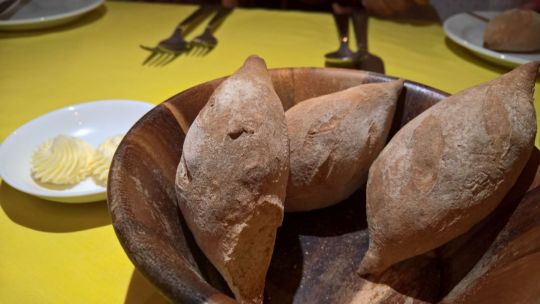
ZaZou’s Country Club version never failed to offer a delightful culinary journey throughout all its courses. Usually, amuse-bouches from the chef helped set the tone for the entire meal, so creations like crab salad beignets and spinach phyllo wraps were a good start.

Chef’s Amuse-Bouche: Spinach Phyllo Wraps and Crab Salad Beignets
Appetizers saw the likes of braised pig trotters on an English Muffin with Bacon Marmalade, Shrimp Boudin with Cilantro Salad and Passion Fruit Dressing, Escargot Florentine with Spinach Velouté and Ahi Tuna Tartare with Roasted Watermelon and Citrus Dressing. And if you thought these sounded fancy, the main stars followed next.

Shrimp Boudin with Saltfish Buljol Cake and Cucumber Daikon
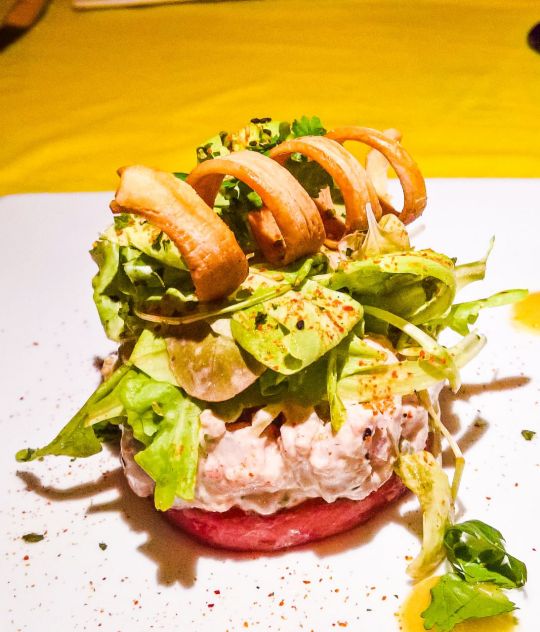
Ahi Tuna Tartare with Roasted Watermelon, Herbs and Lettuce
A classic main course at ZaZou could have gotten you Cornish Hen with Provençal Vegetables, Cocoa Rubbed Pork with Chipotle Sauce, Honey and Tonka Bean Roasted Duck Breast, Pan Fried Lamb with Candied Beet Root and Goat Cheese Mash or Sake-Glazed Atlantic Halibut with Buckwheat Grains and Goji Berries.
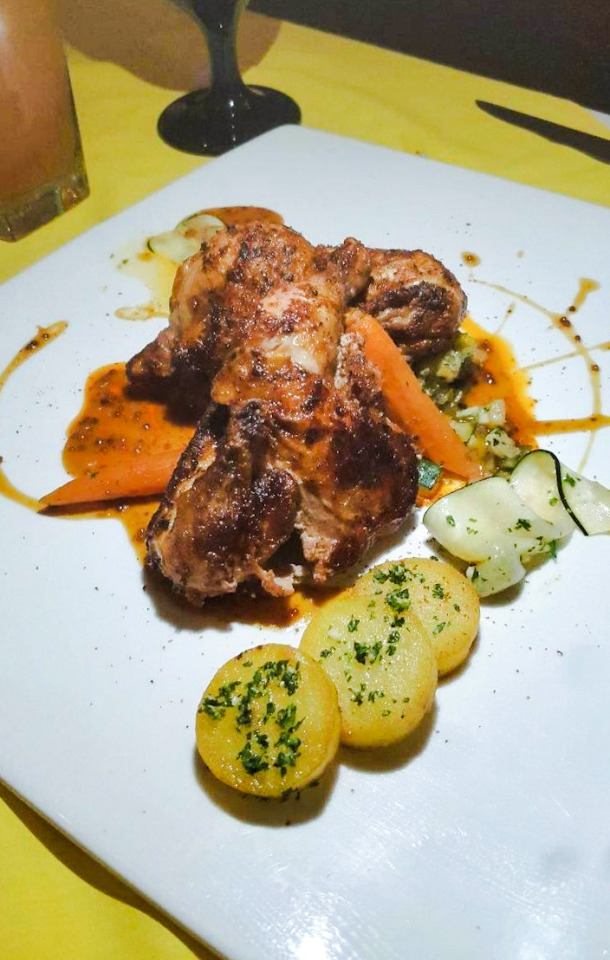
Rosemary Cornish Hen With Vegetables Provençal and Saffron Potatoes
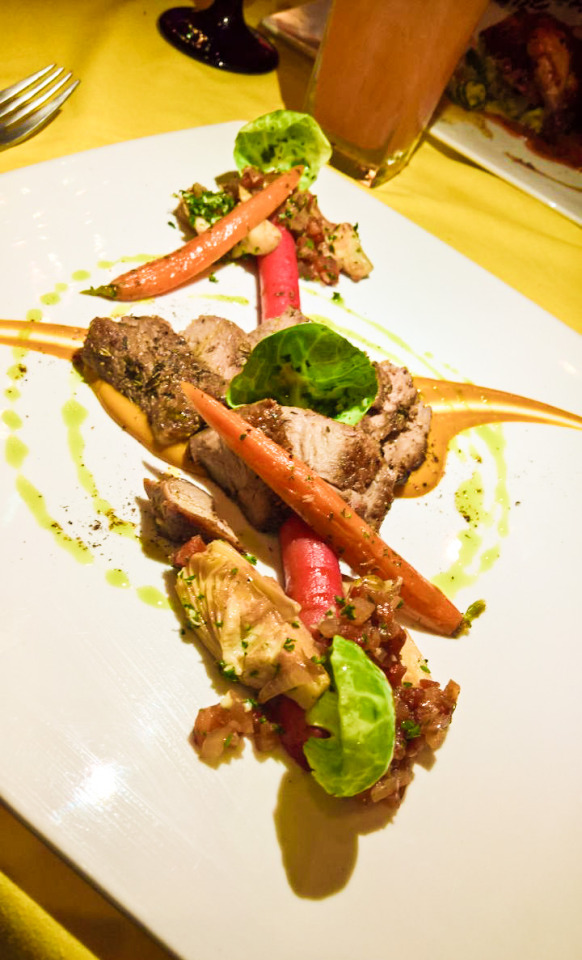
Pan Fried Lamb With Candied Beet Root and Goat Cheese Mash
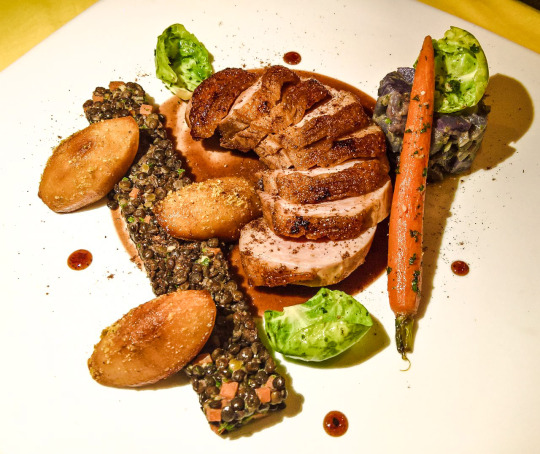
Honey and Tonka Bean Roasted Duck Breast With Puy Lentils Casserole
ZaZou’s dessert offerings were just as delightful as their other courses, and throughout their stay at Country Club they were extra proud to serve organic, house-made ice cream in a variety of flavours. Apple Tartes Tatin, Frozen Nougat Macarons with Candied Peels and Maple Syrup Ice Cream, and Brittany-Style Bretons all made the dessert menu cut.
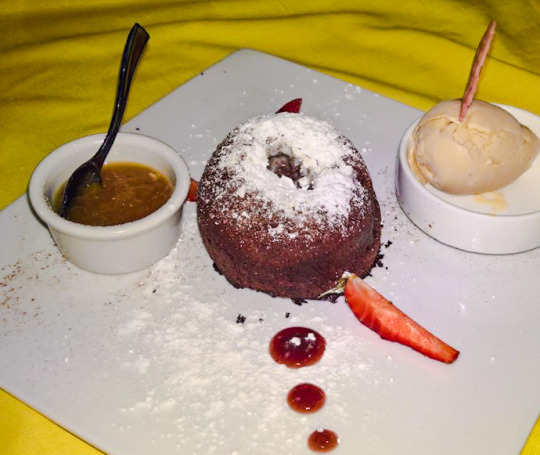
Warm Lava Cake With Orange Ginger Marmalade and Cappuccino Sorbet
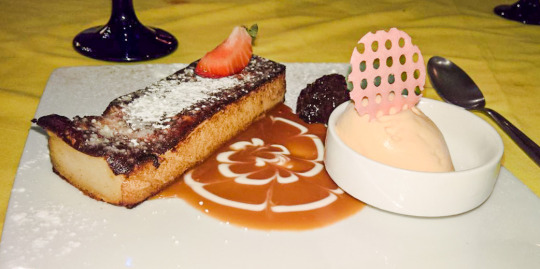
Brittany-Style Breton With Prune Chutney and Dulce De Leche Ice Cream
With just a glimpse of the dishes alone, you can begin to understand what ZaZou’s philosophy is really about – the marrying of culinary creativity and French-styled cooking with fresh local ingredients. ZaZou has always prided itself on letting its food shine, and simple touches like complimentary macarons at the end of meals show just how much food is celebrated and enjoyed under a ZaZou roof.
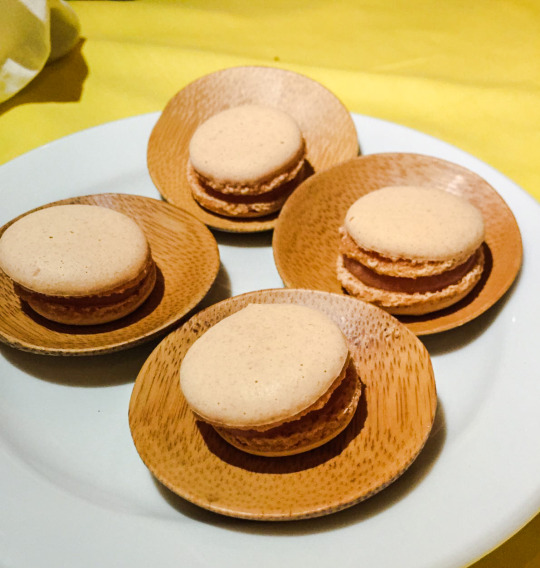
Customer Service – 7 out of 10
Here is where ZaZou scored their lowest. Now, before we half-heartedly mutter something about the norm in Trinidad, keep in mind that ZaZou has always been in the pricey, high-end restaurant bracket. Sure, 7 out of 10 is decent by Trinidad standards, but when you’re out to spend an intimate evening having top-class food in a charming atmosphere, the last thing you want to do is worry about reminding the waiter to refill your water glass, or wonder why you are sitting there 15 minutes after placing a drink order with no thirst-quencher in sight.
And then there was the attitude – but not in the traditional sense, since, to be fair to ZaZou, all their staff were usually very friendly and polite. But there was always a certain underlying haughtiness in the way in which ZaZou employees spoke – as evidenced by a sarcastic remark directed at us by the waiter. Luckily (or unluckily) for them, we passed it off as a joke and decided to take a few extra notes for this review instead! Perhaps the service at ZaZou’s former location was simply due to the holier-than-thou air that Country Club’s history left, but this makes us wonder if the staff’s friendliness was ever really genuine in the first place. Let’s hope ZaZou loses their Country Club attitude on the way to One Woodbrook!
Value for Money – 9.3 out of 10
Specials at ZaZou’s former location were (all-inclusive) TT$367 for a two course meal and TT$435 for a three course meal. Appetizers ranged from TT$105 to TT$160, main courses from TT$204 to TT$426 and desserts were all priced at TT$86.
Despite being relatively expensive, the dishes at ZaZou have always personified attention to detail and originality, two things that are invaluable in the food world and certainly worth spending a little extra for. Menu prices may be unlikely to change at the new ZaZou Kitchen at One Woodbrook Place, and once they are able to maintain their high quality, they will be able to offer excellent value for money.
Overall Experience – 8.5 out of 10
ZaZou has always been one of those names synonymous with extravagance and culinary creativity. After just four years of being in the business, ZaZou has been able to get Trinidadians acquainted with a unique locally-inspired French-styled cooking, and dishes you would find at ZaZou are likely one-of-a-kind on our island. They have successfully been able to appeal to a variety of palettes using levels of flavours drawn from sometimes unlikely ingredients. The ZaZou style of doing things has been to offer a few perfected dishes rather than several mediocre ones, and it is for this reason that Saltin’ has some friendly advice: keep most of your old menu!
ZaZou’s ability to produce quality food with great value for money is likely to translate over to their new location at One Woodbrook Place when they open later this month. Even if the new ZaZou Kitchen maintains its price point as they are likely to do, once they continue to put as much soul into their creations, they will remain one of Saltin’s top recommendations for a food-inspired night (or day) out.
In having to critique fairly, ZaZou did lose some points for its stuffy customer service. But with the changeover to a new location with no history of social segregation as with Country Club, ZaZou may be on its way to finally blossoming.
[Be sure to check back for an update on the new ZaZou Kitchen]
0 notes